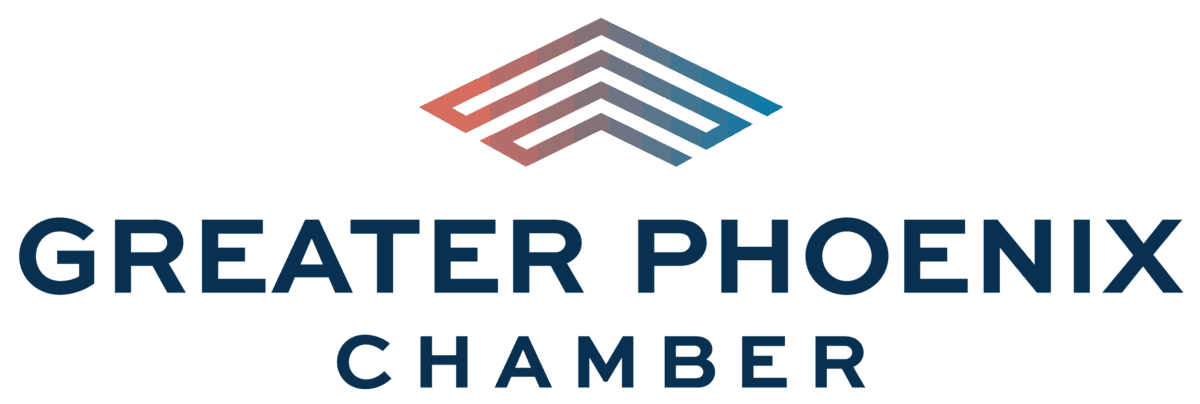On August 19, the Greater Phoenix Chamber hosted the Economic Development Insider Series to debut the Arizona Economic Dashboard, a new tool developed by the Chamber to compile meaningful economic data signaling Arizona’s progress through the economic recovery.
Todd Sanders, President and CEO of the Chamber, Jennifer Mellor, Chief Innovation Officer, and Jennifer Springman, Senior Public Affairs Manager, were joined by local economist, Alan Maguire. Maguire is the President and Principal Economist of The Maguire Company and joined the event to highlight the critical need for the Arizona Economic Dashboard (Dashboard).
“The beginning of 2020 was looking great for Arizona—unemployment was at an all-time low, the state surplus was at about $1 billion, and our corporate attraction funnel was really looking good,” said Mellor. “Then March hit and things came to a slow grind. Since then, we’ve been serving businesses, and we know that there is a tremendous amount of uncertainty, not just for individuals but for those businesses. And that was the impetus for the Arizona Economic Dashboard.”
The Dashboard focuses on crucial leading and lagging indicators in the areas of health care, general economic metrics, real estate, and workforce.
“It’s intended to serve as a one-stop source for all of that information,” said Mellor.
Arizona’s health care sector focuses on supporting the community during the current public health crisis caused by the COVID-19 pandemic.
The health care section of the Dashboard focuses on relevant COVID-19 statistics in Arizona, highlighting changes from the onset on the pandemic, throughout the recovery period, and beyond.
“This is great information because for me to gather this information in other states would take me 45 min to an hour, and I can get Arizona’s information in about 45 seconds using this tool,” said Maguire.
These relevant health care data points will help inform businesses on the local state of the pandemic and provide context as businesses prepare to reopen or return to work.
The economy section includes a broad overview of key economic metrics, including the state sales tax revenue, taxable sales, bankruptcy filings, and many other relevant data points.
When reviewing this data, Maguire encourages people to remember a key factor surrounding this economic crisis. “This is not a traditional recession. A traditional recession develops at the end of the business cycle, and a bunch of factors come into play,” said Maguire. “We had an economy in January and February that was working just fine…the better way to think of this is not as a recession, but as what it was—a shutdown. Our response to this has been and should be different from other downturns.”
It is important to view these data points within the context of the COVID-19 pandemic and understand the leading and lagging indicators within each area of focus.
He also shared a glimmer of hope for businesses. “I expect the third quarter of this calendar year to be better,” said Maguire.
The third section covers relevant real estate metrics, which are mostly lagging indicators. The real estate section includes information provided by CBRE for net absorption rates, vacancy rates, housing starts, permits issued for residential projects, and foreclosure rates.
Maguire noted the importance of Phoenix’s real estate market as it relates to the strength of the region’s economy.
“For most people, their house is their largest single real asset, and so the price of their house is very important to them. It provides an immense sense of security,” said Maguire. “[According to] the Case Shiller index, for the month of May, the Phoenix-Metro area was the metropolitan area with the largest year over year increase, [which was] 9%. The Phoenix market is a very hot market.”
Maguire shared that he anticipates this trend to continue, especially as people continue to relocate to the Arizona market.
Workforce is critical to Arizona’s economic recovery. Workforce, job creation and retention, and strengthening the talent pipeline are vital to a healthy economy. The Dashboard focuses on information about job growth, job creation and loss, and school enrollment.
Prior to the COVID-19 pandemic, job growth was hovering around 3%.
“I expect job growth to recover much more rapidly this time than it did in the 2009-2012 timeframe,” said Maguire. “The nature of the economic impact was very different.”
Maguire highlighted that the last economic crisis really impacted the construction industry the most and that with the current crisis, the impacts were felt across the board and less on an industry by industry basis.
“Hopefully, the recovery will be faster,” said Maguire.
The Dashboard data is updated based on the information source. Some items are updated automatically, and other data points are updated weekly or as information is available.
Access the Arizona Economic Dashboard via www.phoenixchamber.com/azecondashboard.
Interested in attending similar events with a focus on the economy?
Register to attend Economic Outlook 2021 on September 23 or join the Chamber at the next Economic Development Insider Series on October 14.
-Written by Miranda Cain-Morton, Senior Development and Communications Manager кредит на карту
онлайн займы мгновенный займ на карту без проверокхочу получить займонлайн займ без подтверждения карты мониста займзайм от частного лица под расписку спбзайм без звонков на карту онлайн займ всем без отказагде взять займ без отказа отзывызайм без официального трудоустройства


